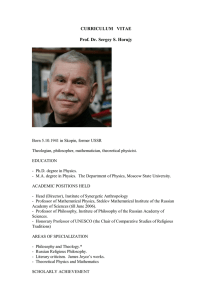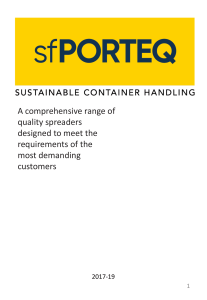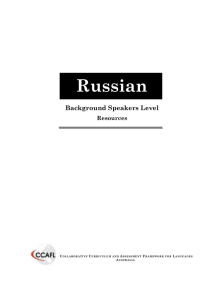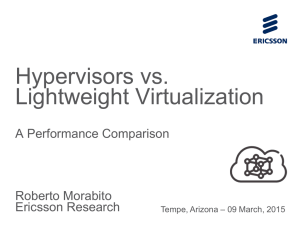Intermodal transportation management
реклама
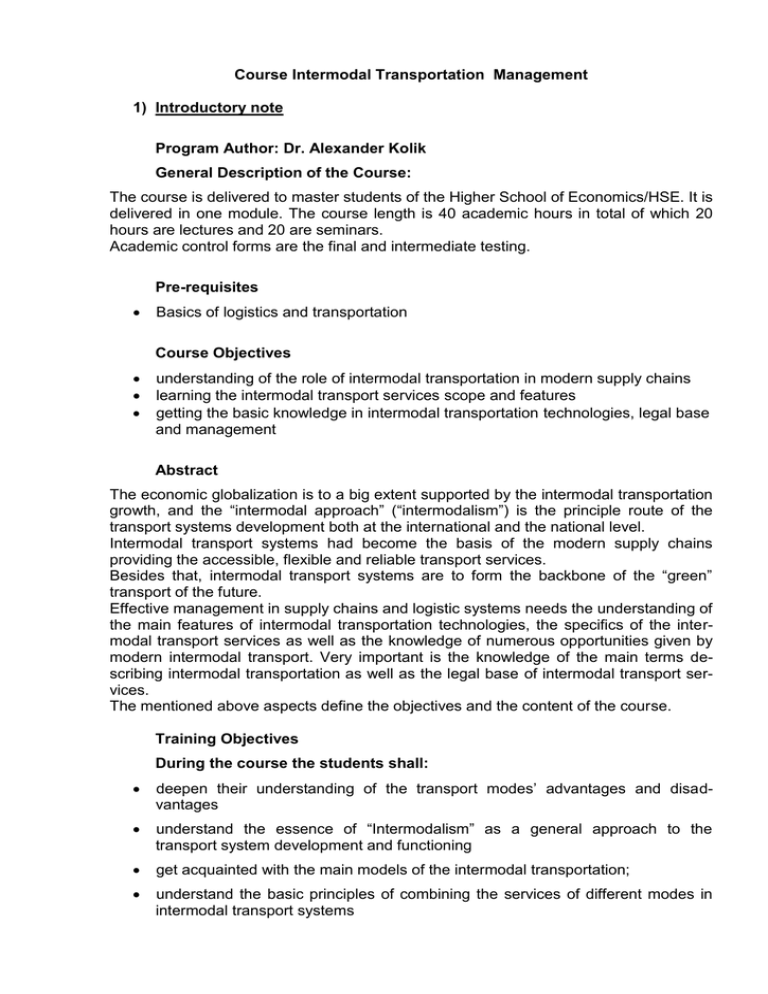
Course Intermodal Transportation Management 1) Introductory note Program Author: Dr. Alexander Kolik General Description of the Course: The course is delivered to master students of the Higher School of Economics/HSE. It is delivered in one module. The course length is 40 academic hours in total of which 20 hours are lectures and 20 are seminars. Academic control forms are the final and intermediate testing. Pre-requisites Basics of logistics and transportation Course Objectives understanding of the role of intermodal transportation in modern supply chains learning the intermodal transport services scope and features getting the basic knowledge in intermodal transportation technologies, legal base and management Abstract The economic globalization is to a big extent supported by the intermodal transportation growth, and the “intermodal approach” (“intermodalism”) is the principle route of the transport systems development both at the international and the national level. Intermodal transport systems had become the basis of the modern supply chains providing the accessible, flexible and reliable transport services. Besides that, intermodal transport systems are to form the backbone of the “green” transport of the future. Effective management in supply chains and logistic systems needs the understanding of the main features of intermodal transportation technologies, the specifics of the intermodal transport services as well as the knowledge of numerous opportunities given by modern intermodal transport. Very important is the knowledge of the main terms describing intermodal transportation as well as the legal base of intermodal transport services. The mentioned above aspects define the objectives and the content of the course. Training Objectives During the course the students shall: deepen their understanding of the transport modes’ advantages and disadvantages understand the essence of “Intermodalism” as a general approach to the transport system development and functioning get acquainted with the main models of the intermodal transportation; understand the basic principles of combining the services of different modes in intermodal transport systems 2 learn how intermodal transport services are utilized in modern supply chains improve the skills of browsing the literature and internet sources on the course topics Target audience Bachelor and master students 2) Thematic Plan Theme 1. Multimodal and intermodal transportation: main concepts and basic models 2. Global container system as the transport basis of modern supply chains 3. Infrastructure of intermodal transport 4. Role of different transport modes in intermodal transport systems 5. Legal base of intermodal transportation Total 3) Class hours lectures 4 Class hours seminars 4 Self study 4 4 12 4 4 4 4 12 12 4 20 4 20 20 68 12 Basic books In English 1) Gerhardt Muller. Intermodal Freight Transportation. 4th Edition– January 1, 1999 2) J. W. Konings. The Future of Intermodal Freight Transport: Operations, Design and Policy . Edward Elgar Publishing, 2008 3) Huub Vrenken, Cathy Macaris, Peter Wolters. Intermodal Transport in Europe. 2005 4) David Lowe. Intermodal Freight Transport. Elsevier, 2005 In Russian 1) Э.Л.Лимонов. Внешнеторговые операции морского транспорта и мультимодальные перевозки. ООО «Модуль», Санкт-Петербург, 2006. – 600 с. 2) Резер С.М. Контейнеризация грузовых перевозок. ВИНИТИ РАН, Москва, 2012 3) Плужников К.И., Чунтомова Ю.А.. Транспортное экспедирование, агентирование и брокераж: Учеб.- М., ТрансЛит, 2012. 4) Education control forms Current control: attendance list Intermediate control: computer testing Final control: oral testing The final grade consists of the following elements: attendance - the weight of 0.1; 3 intermediate testing – the weight of 0.3; final testing – the weight of 0.6. Table: Correspondence of ten-point to five-point system’s marks Ten-point scale [10] Five-point scale [5] 1 – unsatisfactory 2 – very bad 3 – bad 4 – satisfactory 5 – quite satisfactory 6 – good 7 – very good 8 – nearly excellent 9 – excellent 10 – brilliant Unsatisfactory – 2 Satisfactory – 3 Good – 4 Excellent – 5 5) Programme Contents Topic 1 Multimodal and intermodal transportation: main concepts and basic models Topic outline: The main stages of the logistics development and the requirements to transportation evolution. Main prerequisites to multimodal approach development. The general “Intermodal idea” and “Intermodalism” as the practical and scientific approach. Basic terms and definitions. The “Intercontinental” model of intermodal service. The “Intracontinental” model of intermodal service. The implementation of the two models and their interrelation. The main efficiency factors of intermodal transportation. Main references/books/reading: 1) Gerhardt Muller. Intermodal Freight Transportation. 4th Edition– January 1, 1999 Chapter 1 2) Huub Vrenken, Cathy Macaris, Peter Wolters. Intermodal Transport in Europe. 2005. Section “Market” 3) David Lowe. Intermodal Freight Transport. Elsevier, 2005. Chapters 1, 4, 5 4) Резер С.М. Контейнеризация грузовых перевозок. ВИНИТИ РАН, Москва, 2012. Гл.1 5) Плужников К.И., Чунтомова Ю.А.. Транспортное экспедирование, агентирование и брокераж: Учеб.- М., ТрансЛит, 2012. Гл.1. Additional references/books/reading: 4 1) Intermodal Freight Transportation. WILLIAM DEWITT, University of Maryland JENNIFER CLINGER, Louis Berger Group, Inc. http://onlinepubs.trb.org/onlinepubs/millennium/00061.pdf 2) А.Г.Кириллова. Мультимодальные контейнерные и контрейлерные перевозки. ВИНИТИ РАН, М., 2011. Гл.1. 3) Intermodal transportation and containerization. https://people.hofstra.edu/geotrans/eng/ch3en/conc3en/ch3c6en.html Topic 2 chains Global container system as the transport basis of modern supply Topic outline: General descriptions of the global container system. Early days of container system. Containerization and intermodalism. Different modes’ services in container transportation. Types of containers. “Long” and “wide” containers. Containerization of supply chains. Integration of container systems into the supply chains. Containerization and globalization. Main problems of container systems development. Container system of Russia. Alternative intermodal loading units. Contrailer transport system. Swap bodies. European intermodal loading unit. “Running highway”, Roadrailers and other combined transport technologies. Main references/books/reading: 1) Gerhardt Muller. Intermodal Freight Transportation. 4th Edition– January 1, 1999 Chapters 3, 11 2) Huub Vrenken, Cathy Macaris, Peter Wolters. Intermodal Transport in Europe. 2005. Section “Production” 3) David Lowe. Intermodal Freight Transport. Elsevier, 2005. Chapter 1 4) Резер С.М. Контейнеризация грузовых перевозок. ВИНИТИ РАН, Москва, 2012. Гл.2, 4 5) Э.Л.Лимонов. Внешнеторговые операции морского транспорта и мультимодальные перевозки. ООО «Модуль», Санкт-Петербург, 2006. Гл. 5., прил 26. Additional references/books/reading: 1) Container handbook: http://www.containerhandbuch.de 2) The intermodal container web page : http://www.mattsplace.com/intermodal/part1/sea_containers1.htm 3) Колик А. В. Европейская логистика: на пути к универсальной интермодальной транспортной единице? // Логистика и управление цепями поставок. 2013. № 1. С. 77-82. Topic 3 Infrastructure of intermodal transport Topic outline: Intermodal transport corridors. Transport corridor systems in Europe, Asia and Russia. Principal functions of intermodal terminals. Terminal services for shippers and carriers. 5 Hub&Spoke system. Intermodal terminals in sea ports. Inland intermodal terminals. Intermodal terminals’ equipment. Logistic centers and their functions in the supply chains. Intermodal terminals’ operators and their market position. “Terminalization” of modern supply chains. “Floating stock” concept. Examples of intermodal terminals. Main references/books/reading: 1) Gerhardt Muller. Intermodal Freight Transportation. 4th Edition– January 1, 1999 Chapter 10 2) Huub Vrenken, Cathy Macaris, Peter Wolters. Intermodal Transport in Europe. 2005. Section “Infrastructure” 3) David Lowe. Intermodal Freight Transport. Elsevier, 2005. Chapters 4, 5, 13 4) Резер С.М. Контейнеризация грузовых перевозок. ВИНИТИ РАН, Москва, 2012. Гл.4, 11 Additional references/books/reading: 1) Types of intermodal terminals. https://people.hofstra.edu/geotrans/eng/ch4en/conc4en/typesintermodalterminals .html Topic 4 Role of different transport modes in intermodal transport systems Topic outline: Main transport services in the modern supply chains. Liner services and charter services. Characteristics of different modes’ participation in intermodal services. Maritime transport as the backbone of the world container system. Railroads and combined transportation. Road transport and the “last mile” intermodal delivery. Inland waterways integration into the intermodal systems. Aviation and multimodal services. Special features of “Intercontinental” and “Intracontinental” models of intermodal transportation. “Green logistics” priorities and intermodal transportation. Main references/books/reading: 1) Gerhardt Muller. Intermodal Freight Transportation. 4th Edition– January 1, 1999 Chapters 5, 6 2) Huub Vrenken, Cathy Macaris, Peter Wolters. Intermodal Transport in Europe. 2005. Section “Production” 3) David Lowe. Intermodal Freight Transport. Elsevier, 2005. Chapters 6, 7, 8, 9 4) Резер С.М. Контейнеризация грузовых перевозок. ВИНИТИ РАН, Москва, 2012. Гл.6, 10 5) Э.Л.Лимонов. Внешнеторговые операции морского транспорта и мультимодальные перевозки. ООО «Модуль», Санкт-Петербург, 2006. Гл. 8. Additional references/books/reading: 1) Jonas Flodén. Modelling Intermodal Freight Transport. The Potential of Combined Transport in Sweden. - BAS Publishing, Göteborg, Sweden 6 2) Intermodal transportation: https://people.hofstra.edu/geotrans/eng/ch3en/conc3en/ch3c6en.html Topic 5 Legal base of intermodal transportation Topic outline: Basic legal regulations in transportation. Common features and differences in legal base of transportation in Russia and European countries. International regulation of multimodal transport. UN Convention and the FIATA documents. FIATA Multimodal bill of Lading and other intermodal transportation documents. Legal status of the Multimodal Transport Operator. Liability of carrier. Insurance in transportation. Types of Multimodal Transport Operators. Main references/books/reading: 1) Gerhardt Muller. Intermodal Freight Transportation. 4th Edition– January 1, 1999 Chapter 4 2) Huub Vrenken, Cathy Macaris, Peter Wolters. Intermodal Transport in Europe. 2005. Section “Policies” 3) David Lowe. Intermodal Freight Transport. Elsevier, 2005. Chapters 14, 15 4) Э.Л.Лимонов. Внешнеторговые операции морского транспорта и мультимодальные перевозки. ООО «Модуль», Санкт-Петербург, 2006. Гл. 8. Additional references/books/reading: 1) Lin Zhong FIATA Documents and Trade Logistics Standardization http://www.carecprogram.org/uploads/events/2011/Capacity-BuildingSeminar/FIATA-Documents-and-Trade-Logistics-Standardization.pdf Programme author: Alexander Kolik __________________
